#queen maria leopoldina
Text
Imperatriz Maria Leopoldina do Brasil
Ela não era feia e gorda. Se vivia acima do peso, era devido as sucessivas gravidezes. Coisa mais que normal em sua época.
Infelizmente, em vez de culparem o mau caratismo e falta de respeito de Pedro I, sempre culpam a princesa/esposa apaixonada que amava o Brasil.
She wasn't ugly and fat. If she lived overweight, it was due to successive pregnancies. Something more than normal in its time.
Unfortunately, instead of blaming Pedro I's bad character and lack of respect, they always blame a princess/wife in love who loved Brazil

#brasil#brazil#portuguese#habsburg#maria leopoldina#maria#história#history of brazil#secXIX#rainha#queen#secXVII
4 notes
·
View notes
Text

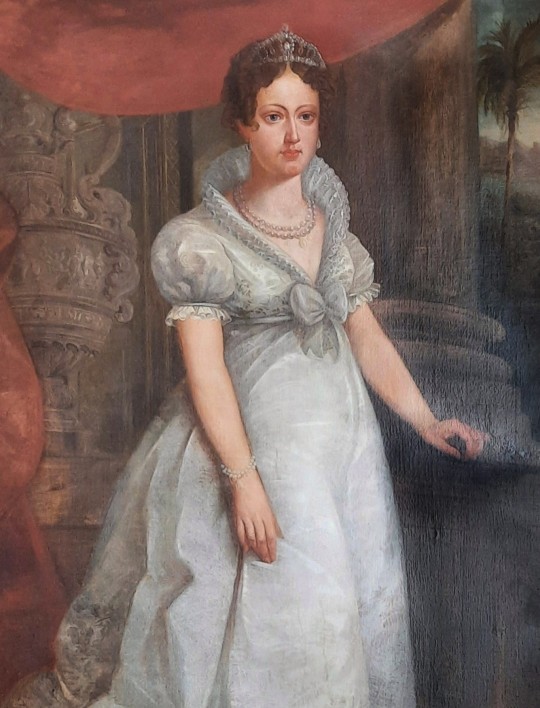
Maria Theresa, Archduchess of Austria, Queen of Hungary, Croatia and Bohemia, etc. reigned 1740-1780
This Maria reformed the empire
From anon: - chucked into ruling at age 23. while pregnant
- no prep!!!! Prussia invades Silesia!!! Ministers fucking around for their own provincial interests instead of for the Whole !!!!! and she has to somehow cope with all of this ....
- ALL WHILE being pregnant with Joseph (II) and we know that guy was just as ornery in utero as he was irl
- she's everything! He (Francis) is just ....Ken.
- YAS QUEEN rediversify that gene pool
- originally reluctant to participate in the 1st partition of poland (who wants galicia let's be real)
Maria Leopoldina, Empress of Brazil, reigned from 1822-1826
This Maria made Brazil independent
33 notes
·
View notes
Photo

Her Imperial Highness, Archduchess Paulina of Augustinia (1764-1805) (formerly Princess Paulina of Norden)
She was born in 1764 at the Schloss Bentswich to Karl Duke of Norden and his Vasian wife, Princess Helene of Vasa. Paulina was the younger fraternal twin of Princess Maria Theresa who would become the Queen Consort of Porto. Princess Paulina had an incredibly close relationship with her twin Maria Theresa and her younger sister Princess Louise. Paulina’s mother Helene enforced a strict education on her daughters which proved to be stressful for the young princess compared to her other daughters. Paulina was loved by her father, while her mother somewhat resented her for her lack of intellectual skills. Despite Paulina’s difficulties in her studies she was still able to learn five languages and studied literature. In 1780, Paulina attended the wedding ceremony of her twin sister, Princess Maria Theresa to Crown Prince Luis of Porto. With Paulina’s two older sisters marrying a King and Crown Prince, the eyes of the Norden Court turned on her. In 1781, Norden found itself at war with several Germanic states such as Bremen which was allied with many other kingdoms and principalities. Due to Norden’s poor international relations, Helena was unable to find a suitable match for her daughter. Paulina corresponded with Maria Theresa often and discussed a potential match between Crown Prince Luis’ younger brother Infante Carlos Duke of Madiera however she found him insufferable when she met him at the wedding and would not convert to Jacobanism. In 1782 tragedy struck when Maria Theresa died during childbirth. Paulina and her mother Helena rushed to Porto to be with Luis and his new son Crown Prince Carlos. Paulina and Helena stayed at the court for seven months where it was suggested that King Luis marry Paulina. Paulina grew close to the king and even considered converting to Jacobanism to be with him and raise her nephew as her own son. However, the Portian government did not approve of the match and sought to find a new alliance. Paulina and Helene returned to Norden in 1783, and her mother decided to focus on finding a match for Paulina. In 1784 with the Calais Revolution starting, Norden allied itself with Augustinia and decided to cement it with marriage. In early 1784, Paulina was married to Archduke Ferindand of Augustinia, second in line to the throne of Augustinia. They were married in a huge ceremony at the Innsbruck Cathedral with the Germanic Court in attendance. Paulina did not convert to Jacobanism and remained Peteran with special permission to marry from the Patriarch. There were two wedding ceremonies, the Jacoban one at the cathedral, and a private Peteran one in the Blue Drawing Room of the Innsbruck Palace. Paulina enjoyed a close relationship with her mother-in-law who her sister Maria Theresa was named after, Infanta Maria Theresa of Almeria. Paulina and her husband Ferdinand did not have a happy marriage at all, shortly after the birth of her first child, Archduke Francis in 1784, she discovered her husband in bed with her lady in waiting, Baroness von Nordheim. Paulina came to detest her husband and tried to avoid him at all times, however she did occasionally perform her wifely duties when she needed to. In 1785 and 1786 she would give birth to two more living children, Archduchess Maria Leopoldina and Archduke Charles. Paulina and her children resided at the Innsbruck Palace where they had a close relationship with the Germanic Empress, Maria Theresa of Almeria. Paulina’s husband Ferdinand was made Governor of Graz and relocated to the Steyr Palace in 1790. Paulina had a close relationship with her three children and was a loving mother. They were raised alongside the children of her brother-in-law Joseph I. In 1792, Paulina’s father-in-law, Ferindand VIII passed away and Joseph became the new Germanic and Augustinian Emperor. Paulina was a leading lady at the coronation celebrations held in Graz, Tyrol, and Augustinia. Paulina was delighted by the marriages of her children, Archduke Francis to Princess Henriette de Valentinois, and Archduchess Maria Leopoldina to Crown Prince Alfonso of Porto. In 1805, Paulina died from a pneumonia at the Innsbruck Palace. Her husband Ferdinand, three children, and sister-in-law Empress Maria Leonora were at her bedside at her death. Paulina, while not close with her youngest sister Viktoria, often wrote to her. Viktoria and her daughter Sophie of Rostock attended the funeral and stayed at the Augustinian Court for two months, hoping to secure a match between Archduke Charles and Sophie, but this failed.
#SophieofRostock#SOR#sims4#ts4#the sims#the sims 4#ts royals#ts4 royals#s4#the sims 4 history#historical#historical royals
70 notes
·
View notes
Photo

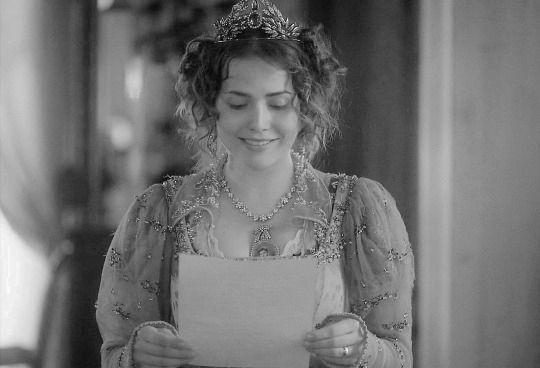



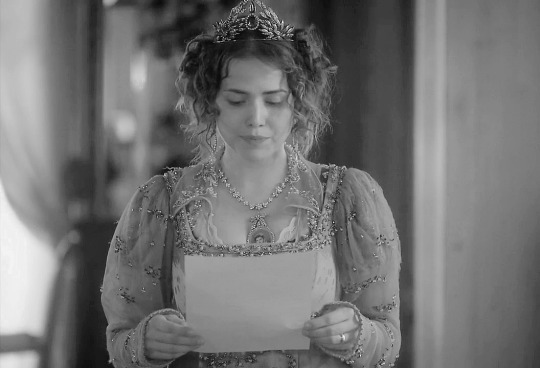

♕ 200 years since the Prince Regent Dom Pedro declared the Independence of Brazil from the United Kingdom of Portugal, Brazil and the Algarves — 7 SEPTEMBER 1822
On September 2, 1822, a new decree from Portugal arrived in Rio de Janeiro while the Prince Regent of Brazil, Dom Pedro, was in a political tour in the Province of São Paulo. The letter overturned the Brazilian government and demanded the immediate return of Pedro to Portugal. Since August 13 the Princess Maria Leopoldina of Austria was the Acting Princess Regent of the Kingdom of Brazil and head of the Council of State in the absence of her husband. Aware that Portugal intended to relegate Brazil again to the status of a simple colony rather than a kingdom united to that of Portugal and fearing a civil war the Princess acted imediately. Maria Leopoldina met in the morning of 2 September 1822 the minister José Bonifácio de Andrada e Silva and summons the Council of State. She signs on that day the Decree of Independence, declaring Brazil separate from Portugal. Leopoldina sends Pedro the news, along with letters from her and from José Bonifácio urging him to proclaim the independence of Brazil. In her letter Maria Leopoldina warns: “The pommel is ripe, pick it up already, or it will rot.”.
On September 7, 1822 at the shore of the Ipiranga River the letters reached the Prince. Dom Pedro turned to his companions and spoke: “Friends, the Portuguese Cortes want to enslave and pursue us. From today on our relations are broken. No ties can unite us anymore” and continued after he pulled out his armband that symbolized Portugal: “Armbands off, soldiers. Hail to the independence, to freedom and to the separation of Brazil from Portugal!”. He unsheathed his sword affirming that “For my blood, my honor, my God, I swear to give Brazil freedom,” and cried out: “Brazilians, from this day forward our motto will be Independence or Death!”. This event is remembered as the “Cry of Ipiranga”. The Prince and Princess then became Emperor Dom Pedro I of Brazil and Empress Consort Maria Leopoldina of Austria, inauguring the Empire of Brazil (1822-1889).
Caio Castro as Emperor Dom Pedro I of Brazil and King Dom Pedro IV of Portugal and Letícia Colin as Princess Maria Leopoldina of Austria, the Empress Consort of Brazil, Queen Consort of Portugal and Archduchess of Austria in “Novo Mundo” (2017).
#novo mundo#perioddramaedit#historyedit#weloveperioddrama#perioddramasource#onlyperioddramas#historicwomendaily#periodedits#userperioddrama#braziliansource#periodedit#women in history#period drama#brazilian history#history#brasil#brazil#maria leopoldina#maria leopoldina of austria#dom pedro i#independência do brasil#pedro i of brazil#novomundoedit#mine#mine: edit#mine: novo mundo#mine: maria leopoldina#mine: dom pedro i#mine: novela#mine: brazilian tv
91 notes
·
View notes
Text
Our Contestants
1: Maria Leopoldina of Austria, First Empress of Brazil
2 Dona Maria I of Portugal
3: Dona Maria II of Portugal
4: Isabel, Princess Imperial of Brazil
5 Carlota Joaquina de Bourbon
6: João I, Duke of Bragança
7 João IV, King of Portugal
8: Afonso I, Duke of Bragança
9: Fernando I, Duke of Bragança
10: Jaime I, Duke of Bragança
11: Teodósio I, Duke of Bragança
12: Teodósio II, Duke of Bragança
13: Afonso VI of Portugal
14 Pedro II of Portugal
15: João V of Portugal
16: João VI of Portugal
17: Pedro II of Portual
18 Pedro I of Brazil/ IV of Portugal
19: Miguel I of Portugal
20: Pedro V of Portugal
21: Luís I of Portugal
22: Carlos I of Portugal
23: Manuel II of Portugal
24 Dom Pedro II of Brazil
25: Teresa Cristina, Empress of Brazil.
26: Catherine de Bragança, Queen Consort of England, Scotland, and Ireland
27: Infante Dom Manuel, Candidate for the throne of Poland
28: José I of Portugal
29: Carol II of Romania (Carlos II in Portuguese)
30: Ferdinand I of Romania
31: Infantá Antonia de Bragança, Princess Consort of Hohenzollern
32: Amélie of Leuchtenberg
33: Infanta Isabel Maria, Regent of Portugal
34: Mariana Vitória of Spain, Queen Consort of Portugal
35: Maria Francisca of Savoy (Consort to Afonso VI and Pedro II)
36: Maria Pia of Savoy (Queen-Consort to Luís I of Portugal)
6 notes
·
View notes
Text
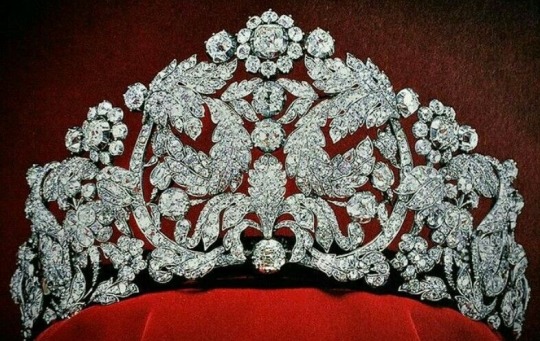
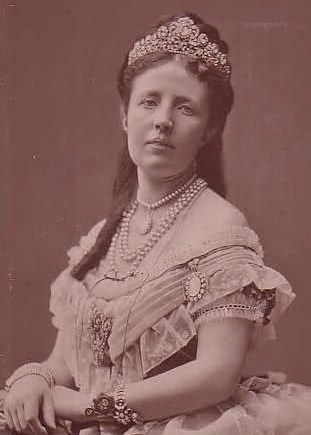
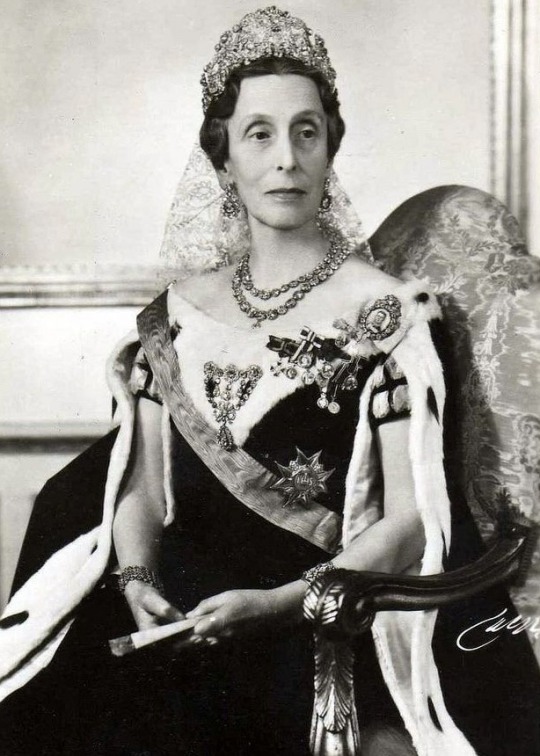


Royal Tiaras Highlights: The Braganza Tiara
The tiara was a wedding gift from Emperor Pedro I of Brazil to his second-wife, Amélie in 1829. The piece was made using diamonds initially given to Pedro’s children by Maria Leopoldina, their mother and Pedro’s first-wife. Pedro bought the diamonds from his children and used them on the tiara, which is said to weigh between 1 and 3 kg and is notoriously uncomfortable to wear. When Empress Amélie of Brazil died, she left her tiaras to her sister Queen Josephine of Sweden, and it remains in the possession of the Swedish Royal Family since.
#my absolute favorite#my precious#so so pretty#tiaras highlights#braganza tiara#swrf#swedish royal family#queen silvia#royal jewelry#royal jewels#royal tiaras
47 notes
·
View notes
Note
Chegando com pedido inusitado, mas acho que vcs conseguem me ajudar. Quero fazer um perso da nobreza, mas queria me basear em gente que já existiu, figuras históricas, mas não sei quais são legais, de verdade, podem me ajudar? Dando apenas o nome posso buscar no google, mas é que sou péssima em história e nunca sei quem é legal
O quanto eu amei essa ask não está escrito!! Pompurin, você veio ao lugar certo, porque eu sou o maior dump de história de realeza (ao menos, que eu conheço). Ser legal já tira todo mundo da lista, porque ninguém foi legal, eles podiam ter ações nobres e sociais, mas era por algum interesse mascarado... Nobreza nunca foi simpática, mas as histórias são magnificas. Vou separar alguns nomes para ti. [ meio edit, acho que vai ficar muito extenso, então depois da Rainha Elizabeth II, não coloquei descrições, apenas em alguns específicos. ]
Lady Di, nossa amada Princesa Diana da Inglaterra (1961-1997). Minha amada mais injustiçada, sou a maior apaixonada por tudo que a envolve (já assisti todos os documentários) e ela é um exemplo perfeito de monarca que foi contra as regras da Coroa Britânica.
Kate Middleton (1982). Atual princesa de Gales e esposa do Príncipe William da Inglaterra, além de se mostrar uma mãe exemplar (com semelhanças com sua sogra), também é um exemplo de monarca, porque ela é muito simpática com as pessoas.
Maria Leopoldina da Áustria (1797-1826). Esposa de Dom Pedro I de Portugal-Brasil. Muito importante em muitos momentos do Brasil Império.
Teresa Cristina de Bourbon-Duas Sicília (1822-1889). Imperatriz do Brasil e esposa de Dom Pedro II. Teve uma novela da Globo que mostrou muito dela, uma mãe amorosa e que cuidava de seu império, mas que teve momentos conturbados com o marido lixo.
Pedro II do Brasil (1825-1891). Último imperador do Brasil. Tenho muitos sentimentos controversos sobre o Pedro, todos envolvendo sua gestão e a mulher dele, mas a história dele vai muito além do que aprendemos na escola.
Cleópatra VII Filopator (69 a.C - 30 a.C). Falar da Cleópatra é muito !!!, ela foi uma das poucas mulheres que governaram o Egito (se não a única) e tem muita história, claro que existem as problemáticas, mas ela sempre foi estrategista e sedutora. Até hoje, seu sarcófago não foi localizado, o que indica que tem muito que não sabemos sobre.
Rainha Elizabeth II (1926-2022). Famosa "Betinha" para os brasileiros, tem muito sobre ela que dá raiva, mas ela teve muitos momentos bons na vida e claro, viveu bastante.
Rainha Vitória (1819-1901). Subiu ao trono com apenas 18 anos e tem a chamada Era Vitoriana.
Ana Bolena (1501-1533). Bela e decapitada por mando do marido, responsável pelo corte da relação Igreja X Inglaterra. Aconselho procurar o musical The Six, porque mostra todas as seis esposas do Henrique e como elas são interessantes.
Ricardo I (1157-1199). Ricardo Coração de Leão, tem uma história legal.
Henrique VIII (1491-1547). Um homem que não presta, teve várias esposas e muitas coisas rolaram no mandato dele. Aconselho ver The Tudors.
Catarina de Médici (1519-1589)
Maria Antonieta (1755-1793). Essa mulher... Vivia de luxúria e a frase dos brioches vem dela.
Luís XIV (1638-1715). Rei Sol.
Nefertiti (1370 a. C.-1330 a. C. - estimada). Descrita como a mais bela do mundo.
Mary Stuart (1542-1587)
Catarina II da Rússia (1729-1726). Nunca deixarei a Catarina, a Grande de fora. Outra rainha que admiro demais, apesar dos erros cometidos, ela foi muito sagaz e inteligente em dar um golpe no próprio marido e assumir o trono de Todas as Rússias, mesmo enfrentando grandes problemas. Existem muitos conteúdos sobre ela, mas se quiser rir, aconselho ver a série The Great.
Pedro III da Rússia (1728-1762). Teve um mandato curto porque foi deposto (sofreu O golpe da Catarina), vivia embriagado... Como ele é mostrado em The Great é um pouco demais, talvez, mas tá ali.
Rei George III do Reino Unido (1738-1820). Aquele rei lá de Queen Charlotte, ele tinha uma doença chamada porfiria, mas na época... Bem, só o chamaram de louco mesmo (aquela época era terrível).
Sophie Charlotte de Mecklemburgo-Strelitz (1744-1818). Assim como muitas figuras históricas, ela foi embranquecida, mas Charlotte era filha de portugueses e africanos, mas nasceu na Alemanha e talvez esse seja o motivo... Mas ela foi uma ótima rainha.
São alguns nomes, aqueles que lembrei para pesquisar, mas se pesquisar sobre os monarcas da Europa, com toda a certeza, vai encontrar uma infinidade! Podia falar outros, mas a Joy disse que ia ficar muita informação e ela está certa, acho que se pesquisar por esses já vai encontrar novos nomes que podem ajudar.

8 notes
·
View notes
Text
there is a historical parallel to queen elizabeth ii: dom pedro ii of brazil.
he died about three decades before she was even born. much like elizabeth, he was thrust into a position of power against his will - he was born to be emperor, but his father abdicated before he was even middle aged due to political pressure and pedro inherited the throne at age 4. it’s often said he could never be a child because he was sternly tutored to be emperor at a young age. ten years later, at 14, the liberal party used legislation to coup the conservative party and fully install pedro ii as emperor of brazil (”golpe da maioridade” or age of majority coup). when he became de facto emperor, however, pedro’s first move was to remove the liberals from power and place the conservatives instead. the cycling of power between parties (so that none of them ever acquired more power over the other) would become his trademark until the end of his reign.
again, much like queen elizabeth, despite hating his position and being generally unhappy because of it, he had a strong sense of duty and wanted to serve his empire. he was an educated man and strove to make brazil a center of education and technology (not that it was all roses - he crushed several revolts against the central government and did paraguay bad. very bad). we were only the second country to receive a telegraph line, during his reign. pedro ii often frequented world science fairs in europe and america. he was famous and known by other world leaders at the time - royalty, a direct descendant of the habsburgs; his mother empress maria leopoldina was a habsburg-lorraine (she died of grief when he was a kid due to an open affair her husband, the emperor, had with another woman in brazil). the royal family in brazil (ahem, unlike today) were abolitionists, and bringing abolition to brazil was what ultimately caused their downfall in 1889. it’s a fair critique that they were wrong to wait that long to hold onto power, but you can’t blame humans for protecting their own power, so for me the fact that they advocated for it and even did it in the end is enough.
(the abolition law has a pretty name though - “the golden law”. its name in portuguese is “lei áurea” after the latin name for gold, which is only vaguely similar in portuguerse, “ouro”, and most people can’t make the connection. it was signed by princess isabel as empress regent under the pretense that the emperor was travelling to europe on business. in fact, i think the royal family leveraged the situation so that the emperor could not be blamed for it, but it failed. or he didn’t have political capital to do it and used the element of surprise, idk. a house member told princess isabel moments after she signed the law: “you may have freed a race, your highness, but you condemned the crown.”)
when republican officers and soldiers couped him with the support of imperial brazil’s agrarian elite (which relied on slave labor), he did not resist. many say that he didn’t believe a woman, his daughter and direct successor, could hold the throne of brazil. in fact, pedro ii was tired, weary, sick and hopeless about the future of the country under the monarchy. he gave it up in the hopes that it would be the better path for his country. in his deathbed, his famous last words were: “may god grant me these two last wishes - peace and prosperity for brazil”.
(i had written a final paragraph making sense of my comparison between the two monarchs but it was wiped out of existence when i edited to include the video. oh well nice post regardless. but in short, i think that those who make best rulers are usually groomed for power but do not want it, which is a difficult combo to achieve)
youtube
1 note
·
View note
Text
Maria Leopoldina, Queen of Portugal (Wife of King Pedro IV)
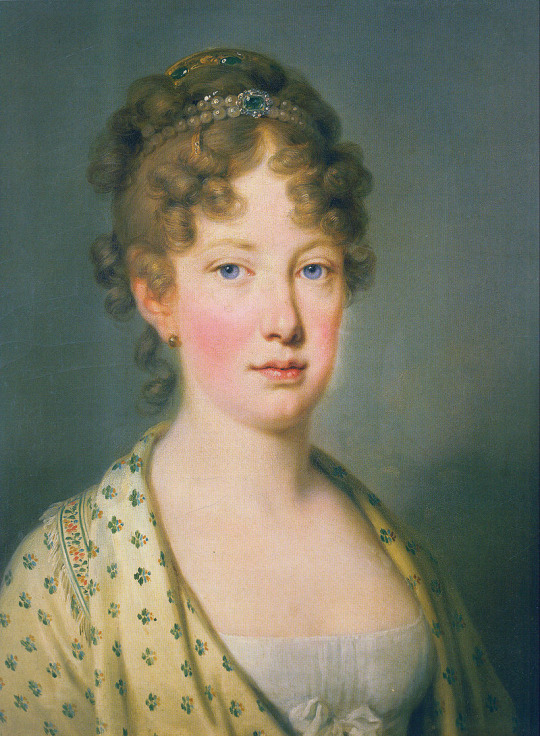
Tenure: 10 March 1826 – 2 May 1826
Maria Leopoldina of Austria (22 January 1797 – 11 December 1826) was an archduchess of Austria, Empress consort of Brazil and Queen consort of Portugal.
She was born Caroline Josepha Leopoldine Franziska Ferdinanda of Habsburg-Lorraine in Vienna, Austria, the daughter of Holy Roman Emperor Francis II,

and his second wife, Maria Teresa of Naples and Sicily.
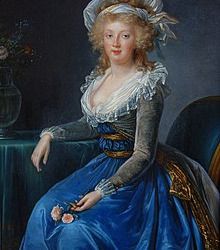
Among her many siblings were Emperor Ferdinand I of Austria
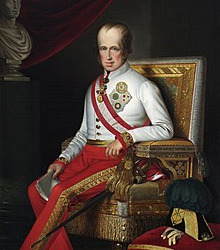
and Marie Louise, Duchess of Parma,
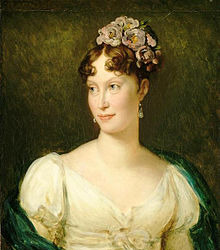
the wife of Napoleon Bonaparte.
Leopoldina was born on 22 January 1797 in Schönbrunn Palace, in Vienna, Archduchy of Austria. She was given the name Caroline Josepha Leopoldine Franziska Ferdinanda, according to her biographer Carlos H. Oberacker, and confirmed by Bettina Kann in her work "Cartas de uma Imperatriz", who mentioned a contemporary source: the Austrian newspaper Wiener Zeitung of 25 January 1797, who gave the news of the birth of the Archduchess three days before with her full name. According to Oberacker, the name "Maria" wasn't present in the preserved baptismal record of the Archduchess, and she began to use it only during her journey to Brazil, where she began to be named Maria Leopoldina in all documents, including the Constitutional oath of 1822. According to another theory presented by Oberacker, the Archduchess probably began to use the name "Maria" due to her great devotion to the Virgin Mary and because all her sisters-in-law used this name.

She was raised in accordance with the educational principles laid down by her grandfather, Emperor Leopold II. Among these was the habit of exercising her handwriting by writing the following text:
“Do not oppress the poor. Be charitable. Do not complain about what God has given you, but improve your habits. We must strive earnestly to be good.”
In addition, she and her sisters were taught to speak French and Latin. They were also educated in drawing, piano, riding and hunting. Her mother died when she was ten years old and her father went on to remarry Maria Ludovika of Austria-Este.
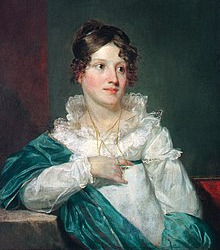
Her late mother was a soprano and Leopoldina had the chance of meeting Johann Wolfgang von Goethe
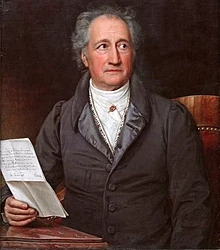
in 1810 and 1812, when she went to Carlsbad with her stepmother. Her passions included natural sciences, especially botany and mineralogy. She was formed according to the three Habsburg principles: discipline, piety and a sense of duty.
Although Maria Theresa of Naples and Sicily was her birth mother, Leopoldina always considered Maria Ludovika d'Este, her stepmother, to be her mother and she grew up with Ludovika as her "spiritual mother".
On 24 September 1816 it was announced by Leopoldina's father that Pedro of Braganza wished to take a Habsburg princess as his wife. Klemens von Metternich suggested that it should be Leopoldina to go get married, as it was "her turn" to become a wife. Two ships were prepared and in April 1817 scientists, painters, gardeners and a taxidermist, all with assistants, travelled to Rio de Janeiro ahead of Leopoldina, whom, in the meantime, studied the history and geography of her future home and learned Portuguese. During these weeks Leopoldina compiled and wrote a vade mecum, a unique document the like of which has never been produced by any other Habsburg princess.
On 13 May 1817 Leopoldina was married to Dom Pedro per procuram (by proxy) in Vienna. At the ceremony the bridegroom was represented by Leopoldina’s uncle, Archduke Charles.
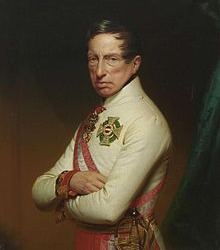
Embarkation took place in Livorno on 13 August 1817

among much celebration, and after an adventure-filled voyage lasting 81 days, Leopoldina arrived in Rio de Janeiro on 5 November and finally met her husband.
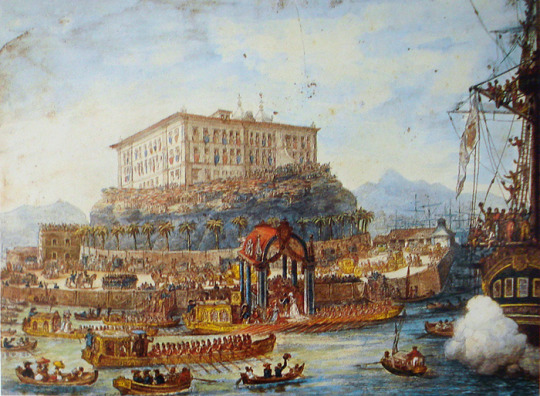
From a distance Pedro initially appeared to Leopoldina to be a perfect, well-educated gentleman, but the reality was very different. Dom Pedro was a year younger than Leopoldina and sadly rarely measured up to the descriptions given by the matchmakers. His temperament was impulsive and choleric, and his education but modest. Even spoken communication between the young married couple proved difficult, as Pedro spoke very little French and his Portuguese could only be described as vulgar.
In keeping with Portuguese tradition, at the age of eighteen Pedro of Bragança not only had a string of amorous adventures behind him and was principally interested in horse racing and love affairs, but in 1817 (the year of his marriage to Leopoldina) he was living as if in wedlock with French dancer Noemie Thierry, who was finally removed from the court by his father a month after Leopoldina's arrival in Rio de Janeiro.
The young married couple took up residence in six relatively small rooms in the Palace of São Cristóvão. The inner courtyard and path to the stables were unpaved and the tropical rainfall quickly turned everything to mud. There were insects everywhere, including in their clothing, for the uniforms and court regalia made of velvet and plush rotted and turned mouldy in the heat and humidity.
On 25 April 1821, the court returned to Portugal. A fleet of 11 ships took the king, the court, the royal house and the royal treasury, and only Prince Pedro remained in Brazil as regent of the country, with ample powers counterbalanced by a regency council. At first Pedro was incapable of dominating the chaos: the situation was dominated by the Portuguese troops, in anarchic conditions. The opposition between Portuguese and Brazilians became increasingly evident. It is clear from Leopoldina's correspondence that she has warmly espoused the cause of the Brazilian people and even desired the independence of the country and is therefore loved and venerated by the Brazilians.
According to Ezekiel Ramirez, below, the signs of a nascent Brazilian unit as an independent nation in the southern provinces were visible, but the north supported the Lisbon Cortes and called for regional independence. If the Prince Regent had left the country at that moment, Brazil would be lost to Portugal because the courts of Lisbon repeated the same error that led the Spanish courts to lose the colonies, seeking to establish direct contacts with each province in particular.
In Rio, thousands of signatures collected required the regents to remain in Brazil. "José Bonifácio de Andrada e Silva's courageous attitude toward Portuguese arrogance greatly encouraged the aspirations for unity that existed in the southern provinces, especially in São Paulo. A highly educated men led this movement." After Fico's day, 9 January 1822, a new ministry was organized under the leadership of José Bonifácio, "strictly monarchist", and the Prince Royal soon won the trust of the people. On 15 February 1822 the Portuguese troops left Rio, and their departure represented the dissolution of the ties between Brazil and the metropolis. The prince was triumphantly received in Minas Gerais.
When her husband, prince regent, traveled to São Paulo in August 1822 to pacify politics (which culminated in the proclamation of Brazil's independence in September), Leopoldina exercised the regency. Great was his influence in the process of independence. The Brazilians were already aware that Portugal intended to call Pedro back, relegating Brazil again to the status of a simple colony rather than a kingdom united to that of Portugal. There were fears that a civil war would separate the Province of São Paulo from the rest of Brazil. Pedro gave power to Leopoldina on 13 August 1822, appointing her head of the Council of State and Acting Princess Regent of the Kingdom of Brazil, with legal powers to govern the country during his absence and set out to appease São Paulo.
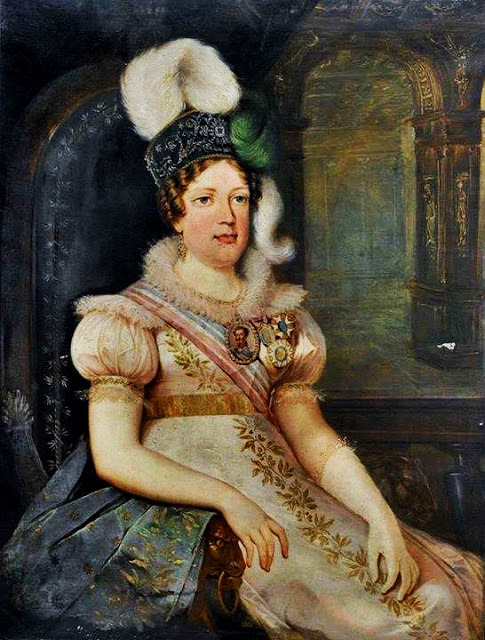
The Princess received news that Portugal was preparing action against Brazil and, without time to wait for Pedro's return, Leopoldina, advised by José Bonifácio de Andrada e Silva, and using his attributes as interim head of government, met in the morning of 2 September 1822, with the Council of State, signing the decree of Independence, declaring Brazil separate from Portugal. The Princess sends Pedro a letter, along with another letter from José Bonifácio, as well as comments from Portugal criticizing the actions of her husband and King João VI. It demands that Pedro proclaim the Independence of Brazil and, in the letter, warns: "The pommel is ripe, pick it up already, or it will rot."
The officer arrived at the prince on 7 September 1822. Leopoldina had also sent papers received from Lisbon, and comments from Antônio Carlos Ribeiro de Andrada, deputy to the courts, for which the Prince-Regent learned of criticism of him in the metropolis. The position of João VI and all his ministry, dominated by the courts, was difficult.
While awaiting the return of Pedro, Leopoldina, the interim ruler of an already independent Brazil, idealized the flag of Brazil, in which she mixed the green of the House of Bragança and the golden yellow of the House of Habsburg. Other authors say that Jean-Baptiste Debret, the French artist who designed what he saw in Brazil in the 1820s, was the author of the national pavilion that replaced that of the old Portuguese court, symbol of the oppression of the old regime. Debret is the design of the beautiful imperial flag, in collaboration with José Bonifácio de Andrada e Silva, in which the green rectangle of the Bragança represented the forests and the yellow rhombus, color of the Habsburg-Lorraine dynasty, represented the gold.
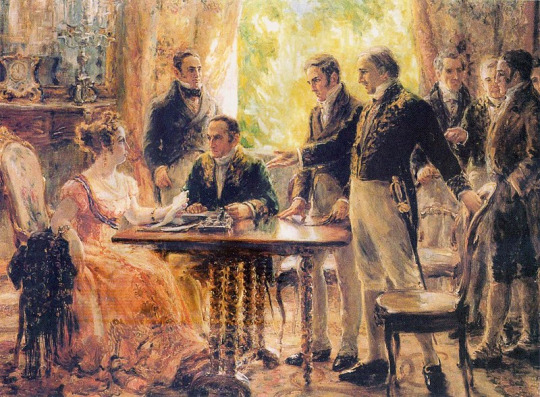
Maria Leopoldina became Brazil's first empress consort. She also played an important role in the process of issuing a Declaration of Independence. On 2 September 1822, a new decree with demands from Lisbon arrived in Rio de Janeiro, while Prince Pedro was in São Paulo.
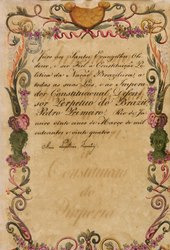
Leopoldina, advised by José Bonifácio, and using her power as Princess Regent, met on 2 September 1822 with the Council of Ministers. She decided to send her husband the news along with a letter advising him to declare Brazil's independence and warned him, "The fruit is ready, it's time to harvest." Prince Pedro declared the country's independence upon receiving the letter on 7 September 1822.
When his father, João VI, died on 10 March 1826, Pedro inherited the Portuguese throne as King Pedro IV, while remaining Emperor Pedro I of Brazil. Maria Leopoldina thus became both Empress consort of Brazil and Queen consort of Portugal. However, two months later, Pedro was forced to give up the Portuguese throne to their seven-year-old daughter Maria.
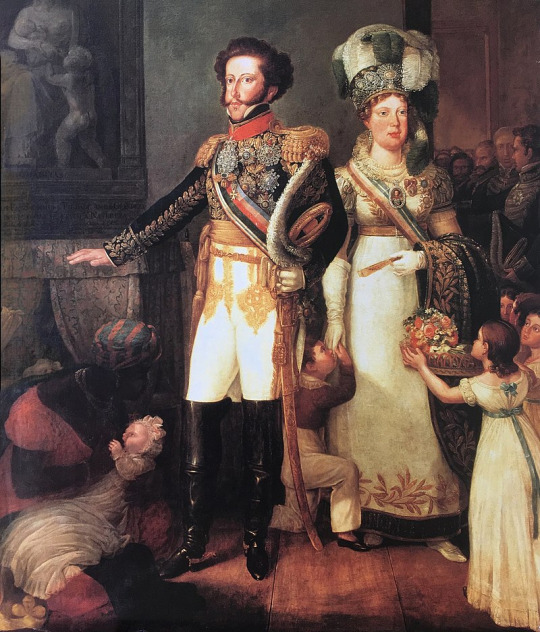
At the end of November 1826, Pedro traveled to Cisplatina (now Uruguay) to join his soldiers. To mark the occasion there was a large farewell reception on 20 November 1826, and Pedro demanded that both women, Maria Leopoldina and his official mistress Domitila de Castro, Marchioness of Santos, appear together before the ecclesiastical and diplomatic dignitaries and receive his kiss on the hand. With the fulfillment of this demand, Maria Leopoldina would have officially recognized her husband's mistress, and for this she refused to appear at the reception. This caused a bitter argument with Pedro, who departed with no resolution to the situation.

Shortly after, Maria Leopoldina became ill, had spells of fever, became delirious at times, and then suffered a miscarriage on 2 December 1826. She died eight days later, on 11 December, five weeks before her thirtieth birthday. She was buried on 14 December 1826 in Rio de Janeiro, in the church of the Ajuda Convent.
Maria Leopoldina had seven children with her husband King Pedro IV of Portugal:
Maria II of Portugal (4 April 1819 –15 November 1853) Queen of Portugal from 1826 until 1853. Maria II's first husband, Auguste de Beauharnais, 2nd Duke of Leuchtenberg, died a few months after the marriage. Her second husband was Prince Ferdinand of Saxe-Coburg and Gotha, who became King Dom Fernando II after the birth of their first child. She had eleven children from this marriage. Maria II was heir to her brother Pedro II as Princess Imperial until her exclusion from the Brazilian line of succession by law no. 91 of 30 October 1835.
Miguel, Prince of Beira (26 April 1820) Prince of Beira from birth to his death.
João Carlos, Prince of Beira (6 March 1821 – 4 February 1822) Prince of Beira from birth to his death.
Princess Januária of Brazil (11 March 1822 – 13 March 1901) Married Prince Luigi, Count of Aquila, son of Don Francesco I, King of the Two Sicilies. She had four children from this marriage. Officially recognized as an Infanta of Portugal on 4 June 1822, she was later considered excluded from the Portuguese line of succession after Brazil became independent.
Princess Paula of Brazil (17 February 1823 – 16 January 1833) She died age 9, probably of meningitis. Born in Brazil after its independence, Paula was excluded from the Portuguese line of succession.
Princess Francisca of Brazil (2 August 1824 – 27 March 1898) Married Prince François, Prince of Joinville, son of Louis Philippe I, King of the French. She had three children from this marriage. Born in Brazil after its independence, Francisca was excluded from the Portuguese line of succession.
Pedro II of Brazil (2 December 1825 –5 December 1891) Emperor of Brazil from 1831 until 1889. He was married to Teresa Cristina of the Two Sicilies, daughter of Don Francesco I, King of the Two Sicilies. He had four children from this marriage. Born in Brazil after its independence, Pedro II was excluded from the Portuguese line of succession and did not become King Dom Pedro V of Portugal upon his father's abdication.
14 notes
·
View notes
Photo
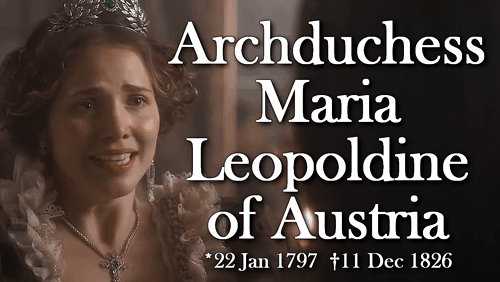



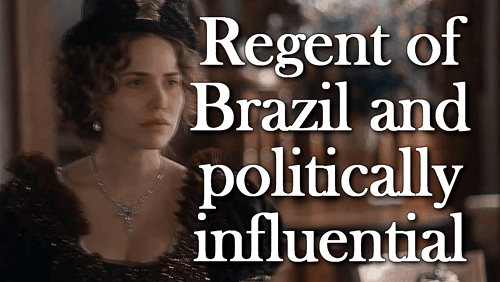





House of Habsburg & of Braganza: Archduchess Maria Leopoldine (Leopoldina) of Austria
Leopoldine Josepha Carolina was born as fifth child and fourth daughter to Holy Roman Emperor Francis II and his second wife Princess Maria Theresa of Naples and Sicily. Her mother died when she was ten but she formed a close relationship with her stepmother Archduchess Maria Ludovika of Austria-Este, Princess of Moden, who her father married only a year after his second wife’s death. Only when she sailed to Brazil, Leopoldine would begin to use the name of Maria Leopoldina.
Leopoldine was raised with her sisters. She studied the typical subjects for Habsburg woman: French, Italian, drawing, playing the piano, riding and shooting. Leopoldine was especially interested in science, most of all botany and mineralogy.
On May 13th, 1817, Leopoldine was married by proxy to the then Prince Pedro of Portugal, who resided in Brazil, in Vienna. Exactly three months later her ship set sail and arrived 81 days later, on November 5th, Rio de Janeiro. Here she met her husband for the very first time. But he was not the fairytale prince she had imagined. At the age of only 18, he had had already several affairs and lived with his French marriage in a quasi-marital situation. However, their marriage would produce nine pregnancies of which 7 were carried to term. Among their children were two monarchs.
However, Leopoldina was influential in the matter of politics. Unlike her, Pedro was also not a very educated man and relied heavily on her advice. He discussed every decision with her up until the indepence of Brazil. Pedro had become Prince-Regent of Brazil in 1821 when his father had to return to Portugal to strengthen his power there. In January 1822, during a expedition to Sao Paulo, a letter reached Pedro from Leopoldina, who he had left behind in Rio de Janeiro as regent in his absence. She advised him to declare Brazil’s independency from Portugal. And he did. They were crowned the first Emperor and Empress of Brazil on December 1st, 1822.
Unfortunately their marriage soon turned sour and abusive. Pedro continued to have affairs and one of them, Domitila de Castro, even bore him a daughter he demanded to be raised alongside his legitimate children. To embarrass Leopoldina, Pedro made Domitila the highest-ranking lady-in-waiting of his wife and gave her the title of Marchioness of Santos. The couples disagreements turned from psychologial to physical. Pretty soon Pedro began to beat his wife. His humiliations at court pushed Leopoldina in too a severe depression.
Maria Leopoldina was pregnant again when she had another fight with her husband on December 1st, 1826. Supposedly, he kicked her so strongly in the stomach that she went into premature labor. Only ten days later, the not yet 30-year-old Empress was dead.
// Letízia Colin as Leopoldina in Novo Mundo (2017)
____________________________________________________________
Requested by @elizabethbennetz
#historic women#historyedit#Novo Mundo#period drama#perioddramaedit#Maria Leopoldina of Austria#Empress Maria Leopoldina of Brazil#women in history#House of Habsburg#House of Habsburg-Lorraine#Maria Leopoldine of Austria#House of Braganza#1800s#19th century#Brazilian history#Latin American history#Austrian history#European history#Royal Women of Austria#queens of the iberian peninsula#requests
343 notes
·
View notes
Text
Share a coke with:
your favorite historical queen
#coke cole#coke#history#historical figures#historical#historical queens#marie antoinette#maria leopoldina of austria#hürrem sultan#empress sissi#elisabeth of austria
21 notes
·
View notes
Text



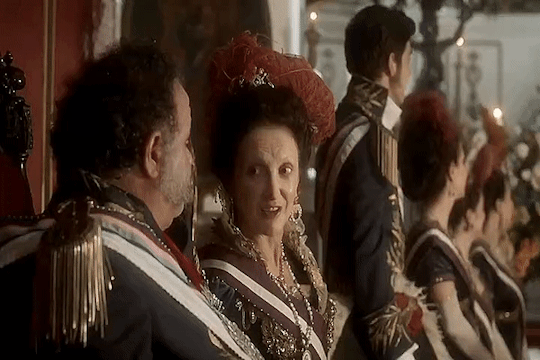

Carlota Joaquina de Borbón (1775 – 1830)
She was the second child of King Carlos IV of Spain and Maria Luisa of Parma. Despite the rigidity of her education and court etiquette, the Infanta was described as mischievous and playful. Maria Luisa would go down in history as one of the most unpopular queens in Spain and her bad reputation deeply affected her children, especially Carlota, the firstborn daughter.
Carlota Joaquina married King João VI of Portugal in 1785. Detested by the Portuguese court — where she was called "the Shrew of Queluz"— Carlota Joaquina gradually won the antipathy of the people, who accused her of promiscuity and influencing her husband in favor of the interests of the Spanish crown.
Carlota Joaquina's husband was good-natured, indolent, corpulent and almost as ugly as she was. His religious observances bored her, and they were quite incompatible. Nevertheless, she gave birth to nine children during their marriage and, because they were all handsome, it was rumoured that especially the younger ones had a different father.

Carlota Joaquina organized a plot with the intention to take the reins of power from her husband, arresting him and declaring that he was incapable of rule like his mother. However in 1805 this plot was discovered, but Carlota Joaquina was saved because her husband, wishing to avoid a public scandal, opposed to her arrest, preferring to confine his wife to Queluz Palace and Ramalhão Palace, while he himself moved to Mafra Palace, effectively separating from her. At that time Carlota Joaquina's enemies claimed that she had bought a retreat where she indulged in sexual orgies.
In 1807, the Portuguese royal family left Portugal for Brazil because of the Napoleonic invasion. Carlota Joaquina also planned to usurp the Spanish crown that was in the hands of Napoleon's brother Joseph Bonaparte. After the marriage in 1817 of her son Pedro with the Archduchess Leopoldina of Austria and the later return of the royal family to Portugal in 1821, Carlota Joaquina was confined in the Royal Palace of Queluz. Her husband died in March 1826. Claiming ill-health, Carlota Joaquina refused to visit his deathbed and started the rumour that her husband had been poisoned by the Freemasons. Carlota Joaquina died in Queluz four years after, alone and abandoned by her children. It is speculated whether she died because of natural causes or whether she, in fact, killed herself.
Débora Olivieri portrays Queen Carlota Joaquina in "Novo Mundo 2017"
#Carlota Joaquina de Borbón#Women in history#Portuguese history#Brazillian history#João VI of Portugal
14 notes
·
View notes
Text

Here's where we stand after Round 1 on the first side
The matches for round 2 (which will start after the other side finishes) will be:
Joseph II, Holy Roman Emperor vs Pedro II, Emperor of Brazil
Mary of Hungary, Governor of the Netherlands vs Karl I, Emperor of Austria
Maria Leopoldina, Empress of Brazil vs. Napoleon II, Duke of Reichstadt
Maximilian I, Holy Roman Emperor vs. Maria Theresa, Archduchess of Austria, Queen of Hungary, etc.
17 notes
·
View notes
Note
Hello dear :) I hope you are doing ok !
Since you talked about you started to be interested in your country history, I have a question stuck in my mind.
What your favorite portuguese historical period ? and why ? Maybe have a fav king ? queen ?
Bonne journée !
Hi lovely! :) I'm good and I hope you are, too!
And oh, I'm not portuguese, I'm brazilian heh, maybe my answer in that ask was confusing, so sorry! My country was discovered by the portuguese circa 1500 given the Treaty of Tordesillas, which btw our dear Papa Borgia played a role with it. If Rodrigo had decided to divide the newly discovered places outside of Europe differently, the spaniards might have discovered us instead of the portuguese, and I would be speaking spanish right now....that's a constant thought in my head ngl hah, but anyways, since the discovery, we of course established a tie with Portugal :)) and we had an Imperial period, which it's my favorite period <3 I really like Dom Pedro I as emperor (our Pedrão as he is sometimes affectionately called here, followed by the nicknames "the Liberator" and "the Soldier King") and his son Dom Pedro II, as well as the empresses Maria Leopoldina of Austria and Teresa Cristina of the Two Sicilies.
Merci pour la question et Bonne journée à vous, aussi! 🥰
#ask answered#hardcorefangirlgroupie#completely oblivious to it my father-in-law *coughs* I MEAN rodrigo dsjdsjds actually had a place in shaping my country's history#and we even have a city here named after his great-grandson the holy~~ Juan and i love that sm <33
2 notes
·
View notes
Photo
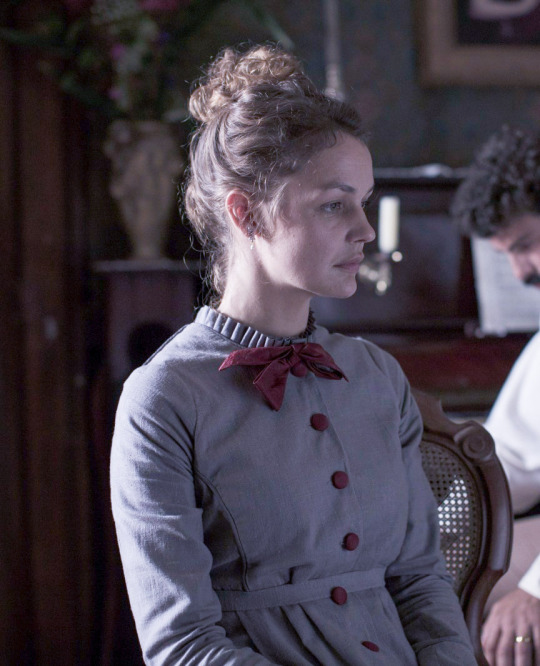

Luise Heyer as Maria Leopoldina of Austria, the Empress Consort of Brazil, Queen Consort of Portugal and Archduchess of Austria
Dona Maria Leopoldina of Austria (22 January 1797 – 11 December 1826) was born Caroline Josepha Leopoldine Franziska Ferdinanda of Habsburg-Lorraine in Vienna, Austria, Holy Roman Empire. She was the daughter of Holy Roman Emperor Franz II and Empress Maria Theresa of Naples and Sicily. In 1817 the Archduchess married Prince Dom Pedro of Braganza (12 October 1798 – 24 September 1834), heir to Portugal, later the Emperor Dom Pedro I of Brazil and King Dom Pedro IV of Portugal. The couple had 7 children: Queen Maria II of Portugal, Miguel, Prince of Beira, João Carlos, Prince of Beira, Princess Januária of Brazil, Princess Paula of Brazil, Princess Francisca of Brazil and Emperor Dom Pedro II of Brazil. On September 2, 1822 while she was the Acting Princess Regent of the Kingdom of Brazil in the absence of her husband Maria Leopoldina signed the Decree of Independence, declaring Brazil separate from Portugal. She died at age 29 in 1826 after a miscarriage. As Acting Regent Maria Leopoldina was the first woman to govern an independent Brazil, the first empress consort of the country, the first empress of the Americas and the first woman to govern an independent American country.
Victoria Guerra as Amélia of Leuchtenberg, the Empress Consort of Brazil and Duchess of Braganza
Dona Amélia of Leuchtenberg (31 July 1812 – 26 January 1873) was born Amélie Auguste Eugénie Napoléonne de Leuchtenberg in Milan, Kingdom of Italy. She was the daughter of Eugène de Beauharnais, Duke of Leuchtenberg and Princess Augusta of Bavaria, Duchess of Leuchtenberg. She was the second wife of Emperor Dom Pedro I of Brazil after their marriage in 1829 and they had one child, the Princess Maria Amélia of Brazil. After Dom Pedro I abdicated the Brazilian crown, Amélia accompanied her husband back to Europe. They held the titles of Duke and Duchess of Braganza until Pedro’s dead in 1834. Amélia died in Lisbon at the age of 60 in 1873.
A VIAGEM DE PEDRO | PEDRO, BETWEEN THE DEVIL AND THE DEEP BLUE SEA (2021). Dir. Laís Bodanzky
#a viagem de pedro#perioddramaedit#filmedit#movieedit#weloveperioddrama#worldcinemaedit#perioddramasource#onlyperioddramas#historicwomendaily#periodedits#braziliansource#cinematv#cinemapix#fyeahmovies#motionpicturesource#filmtv#filmtvdaily#userperioddrama#femaledaily#femalecharacters#flawlessbeautyqueens#historyedit#women in history#period drama#pedro between the devil and the deep blue sea#brazilian cinema#brazilian movies#mine#mine: edit#brazilian stuff
74 notes
·
View notes
Text
AUGUST
Prince of Saxe-Coburg and Gotha
(born 1818 - died 1881)
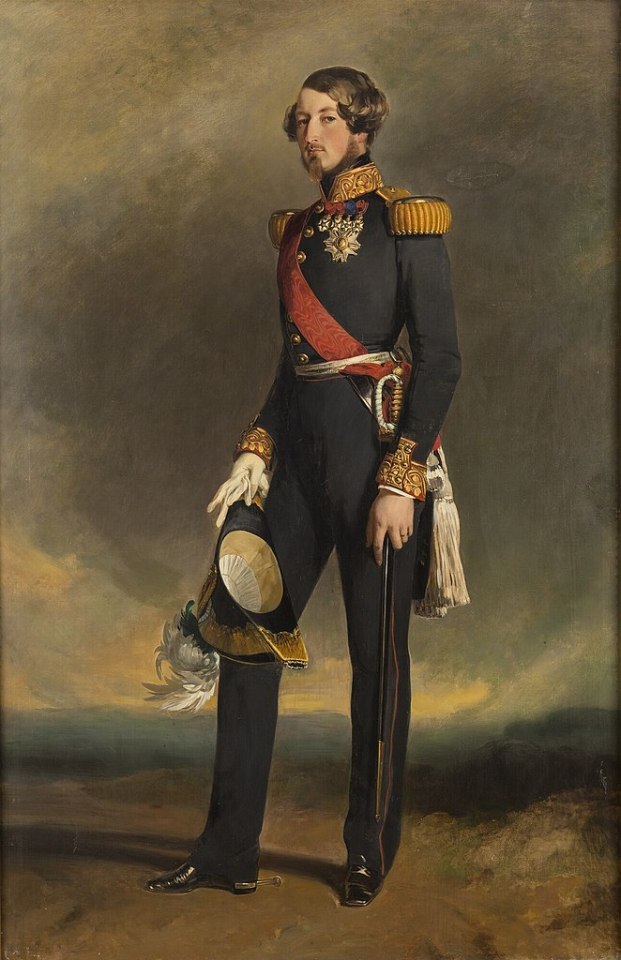
pictured above is a portrait of the Prince of Saxe-Coburg and Gotha, by Franz Xaver Winterhalter from c. 1845
-------------------- ~ -------------------- ~ --------------------
SERIES - On this day July Edition: August died on 26 July 1881.
-------------------- ~ -------------------- ~ --------------------
AUGUST VIKTOR LUDWIG was born in 1818, in Vienna. His parents were Prince Ferdinand of Saxe-Coburg-Saalfeld and Princess Mária Antónia Koháry of Csábrág and Szitnya, of Hungarian nobility.
He was born into the Saxe-Coburg-Saalfeld line of the Ernestine branch of the HOUSE OF WETTIN, a dynasty that ruled Saxon territories in the Holy Roman Empire since the 11th century. And thus was from birth a PRINCE OF SAXE-COBURG-SAALFELD.
In 1826 his maternal grandfather Ferenc József, Prince Koháry of Csábrág and Szitnya died and his mother inherited the rich Koháry estate in Hungary.
That same year his uncle Ernst III, Duke of Saxe-Coburg-Saalfeld concluded an agreement with other members of the Ernestine branch of the House of Wettin over the Duchy of Gotha, whose ruler had died the year before. By this agreement Saalfeld was exchanged for Gotha and thus his uncle became Ernst I, Duke of Saxe-Coburg and Gotha.
This event created a new cadet branch of the House of Wettin, the HOUSE OF SAXE-COBURG AND GOTHA, of which he was technically a member. However as his immediate family was in control of the Koháry estate in Hungary they became known as the HOUSE OF SAXE-COBURG AND GOTHA-KOHÁRY, although he was officially a PRINCE OF SAXE-COBURG AND GOTHA.
In 1843 he married MARIE CLÉMENTINE LÉOPOLDINE CAROLINE CLOTILDE, a Princess of Orléans, the youngster daughter of Louis-Philippe I, King of the French and Princess Maria Amalia of Naples and Sicily. With her he had five children (check the list below).
Although he was not the eldest son he inherited the Koháry estate when his mother died in 1862, because his brother Ferdinand II, King Father of Portugal had renounced his rights to marry Maria II, Queen of Portugal in 1836. And through this inheritance he became a wealthy man, owning properties in Austria and Hungary.
Aged 63, the Prince of Saxe-Coburg and Gotha died on 26 July 1881, at one of his Austrian residences Schloss Ebenthal in Carinthia. He was buried at St. Agustin, a Roman Catholic Church in Coburg, that he had built to serve as his family's mausoleum.
-------------------- ~ -------------------- ~ --------------------
AUGUST and his wife CLÉMENTINE had five children...
Prince Philipp of Saxe-Coburg and Gotha - husband of Princess Louise of Belgium;
Prince Ludwig August of Saxe-Coburg and Gotha - husband of Princess Leopoldina of Brazil;
Princess Clotilde of Saxe-Coburg and Gotha - wife of József Károly, (titular) Palatine of Hungary;
Princess Amalie of Saxe-Coburg and Gotha - wife of Duke Maximilian Emanuel in Bavaria; and
Ferdinand I, Tsar of Bulgaria - husband first of Princess Maria Luisa of Bourbon-Parma, second of Princess Eleonore Reuss of Köstritz and third of Alžbeta Brezáková.
-------------------- ~ -------------------- ~ --------------------
In History, specially Royal History, everything is somehow connected!
And through his relatives the Prince was well connected to many Royal Families around the world, such as:
Belgium, as a nephew of King Leopold I;
Portugal, as a younger brother of King Fernando II;
United Kingdom, as a first cousin of Queen Victoria;
France, as a son-in-law of King Louis-Philippe I;
Bulgaria, as the father of Tsar Ferdinand I; and
Brazil, as the father-in-law of Princess Leopoldina.
#august of saxe coburg and gotha#prince august of saxe coburg and gotha#prince of saxe coburg and gotha#saxe coburg saalfeld#house of saxe coburg saalfeld#saxe coburg and gotha#house of saxe coburg and gotha#saxe coburg and gotha kohary#house of saxe coburg and gotha kohary#german royals#german royalty#royals#royalty#monarchy#monarchies#royal history#german history#hungarian history#european history#world history#history#history lover#19th century#louis philippe#leopold i#queen victoria#fernando ii#history with laura
3 notes
·
View notes